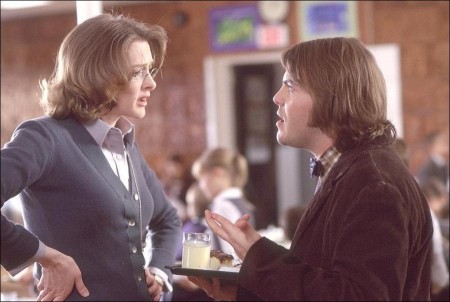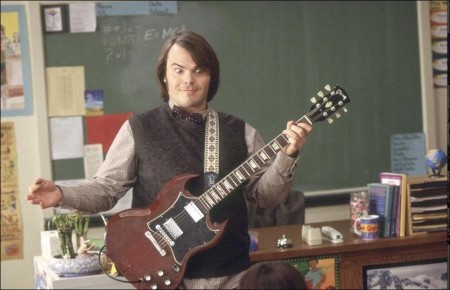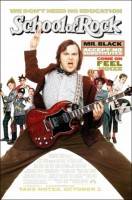As far as Jack Black and Dewey Finn are concerned, the actor and the character he portrays couldn’t be more similar or different. Black is the singer, songwriter, guitarist of his own band Tenacious D, and Finn is a singer, songwriter and guitarist of his own band No Vacancy.. .except they kick him out. And, while rock ‘n’ roll is a significant part of Black’s life, rock ‘n’ roll is the only thing in Einn’s life.
“I just love the way Mike writes,” admits Black. “Not only does he have that funny edge that suits me, but also he knows how to get into my voice.”
Screenwriter White, who lived next door to Black for three years, had been wanting to write a film geared specifically to Black’s unique personality.
“Jack is a great performer, a terrific musician and the perfect antihero,” says White. “He’s kind of unhinged in that fun way that Willie Wonka is, and I kept having this idea about him jamming around with a bunch of kids.”
With the genius of Black’s stellar comedic style and White’s clever script, “The School of Rock” already exceeded the parameters of a traditional comedy, but when the filmmakers recruited director Richard Linklater, they knew they had someone at the helm of the film who could take it even further. Known for such landmark independent films as “Slacker” and “Dazed and Confused,” Linklater also happens to have a penchant for making movies with a heavy influence of rock ‘n’ roll.
“I’m a big fan of Jack, both as a musician and as an actor,’ says Linklater. “And Jack’s character, a struggling musician willing to do almost anything to help realize his dreams, reminded me of my formative years as a filmmaker.”
“Rick (Linklater) brings reality, honesty and believability to the film,” explains Black. “He reins me in, which is important because I’m always going 10 miles too far over the top. So when I go a little too crazy, he brings me back to reality.”
Not unlike the actor who portrays him, the fiery Dewey Finn is on the verge of exploding throughout “The School of Rock.” First, he gives a volatile performance with his band, launching into a long guitar solo and stage-diving into the crowd with no one there to catch him. Next, while masquerading as his roommate, substitute teacher Ned Schneebly (Mike White), Dewey discharges lectures on the wonders of rock and the evils of “The Man” to a wide-eyed class of fifth graders. And finally, in the end, he ignites his students into giving the performance of their lives at the Battle of the Bands.
There to constantly snuff out Dewey’s fuse is straight-laced Rosalie Mullins (Joan Cusack), the always uptight unless she’s had a few beers principal of the prestigious private school where Dewey is substitute teaching. “I’m Dewey’s nemesis, and I could blow the whistle on him at any moment,” explains Cusack. “It’s a great role because, down deep, Rosalie Mullins really wants to let loose and be wild. So in a way, I guess she sort of admires Dewey.”
Black, who appeared with Cusack and her brother, John, in the critically acclaimed “High Fidelity,” says working with Joan again was a blast. “She’s very funny,” observes Black. “It was great watching her character crack.”
“Joan is awesome,” agrees White. “She usually plays these sort of blithe spirits, so it’s funny to see her as the uptight, buttoned-down principal. It’s also great to watch her and Jack go at it.”
Rounding out the principal cast with her portrayal of Ned Schneebly’s bossy girlfriend, Patty, is former “Saturday Night Live” writer/comedienne Sarah Silverman. who says that while her role in the film wasn’t comedic, she was glad to play the foil for a change.
“Once I read Mike White’s script, I just had to be in the film,” remembers Silverman. “I don’t usually get to play the ‘bad guy,’ so it was a great chance for me to do something a little different. Besides, let’s face it: If you’re in a film with Jack Black, right from the start you know it’s going to be pretty damn funny.”
About The Kids
Once the principal cast members were in place, the real challenge was to fill the classroom with musically talented kids. Producer Scott Rudin, director Richard Linklater. casting director Ilene Starger and music supervisor Randall Poster all shared the same thoughts about authenticity.
“We cast children who could actually play these instruments and sing.” explains Starger, who saw several thousand children in cities that included New York. Los Angeles, Chicago, Minneapolis, San Francisco and Seattle throughout the five-month casting process.
“In the end, we struck a great balance, mostly choosing kids who are not the classic Hollywood actors,” says Poster. “All of them have a fresh sweetness about them, and each definitely brings something special to the film.”
Two members of “The School of Rock” band, 11-year-old classical guitarist Rebecca Brown (bass player Katie) and 12-year-old classical pianist Robert Tsai (keyboard player Lawrence), were found through “From the Top,” a Public Radio International program featuring performances from young classical musicians. “From the Top.” which originates from WGBH Boston, provides information, entertainment and education for pre-college-age musicians, their parents and teachers, and Rebecca and Robert were real finds.
Joey Gaydos Jr.. who portrays Zack, the lead guitarist, is a resident of Belleville, Michigan. Now 12, he began playing the guitar at eight, and started his own band in Michigan. He was found through Dayjams, a summer program that provides the opportunity for kids between the ages of nine and 15 to study guitar, bass, drums, keyboards and vocals. Founded by the National Guitar Workshop (NGW), Day jams is the nation’s largest summer music program.
Kevin Clark who portrays Freddy, the rebellious drummer, was discovered at an open casting call in Chicago. He started playing drums with local community bands at the age of three, at which time he would wander up on stage and break into a drum solo to standing ovations. He began formal percussion lessons in fifth grade and has been drumming ever since.
“Many of the kids in our cast had never auditioned before, let alone been in a movie,” says casting director Ilene Starger. “In fact, one of the great things about this project was watching their progress.
For example, 10-year-old Maryam Hassan, who plays shy Tomika, had appeared only in school plays, but when she heard about an open call in New York through the Internet, she and her mother drove into the city from Long Island for the auditions. Maryam belted out her version of Jennifer Holliday’s solo from “Dreamgirls” and the role was hers.
Being a musician/singer himself, Jack Black recognized the talent in his costars immediately. “These kids were amazing musicians from the start and they took direction really well,” says Black. “I mean, the performances Rick [Linklater] drew from them were really something.”
Because auditions took place in more than 10 U.S. and Canadian cities, the cast of talented kids came from diverse locations, but soon after gathering in Manhattan to begin working on the film, they became a tight-knit unit.
From veterans Angelo Massagli (Frankie, head of band security), who plays Bobby Jr. in “The Sopranos,” and Aleisha Allen (Alicia, the backup singer), who appeared in “The Best Man” and “Finding Forrester,” to newcomers Maryam Hassan (Tomika) and Robert Tsai (Lawrence), who had never stepped foot on a movie set in their lives, all the kids quickly adapted to their busy schedules of practicing the music, filming and regulated classroom time. In the end, they became so comfortable with performing that, during the final weeks of filming, two young cast members, Joey Gaydos Jr. and Kevin Clark, actually appeared at a local club with their teacher, Amanda Kaupousouz, a talented Irish fiddler.
Making Music
While the casting was under way, music supervisor Randy Poster, who had worked with director Richard Linklater previously on “SubUrbia,” set out to build a musical team. The first thing he did was to bring in a ringleader for the kids Jim O’Rourke, who produces and plays with Sonic Youth.
“One of the great advantages of this movie is that we had 10 weeks where we basically put the kids in rock-and-roll boot camp,” says Poster. “In that way both before and during production the kids became very comfortable with their instruments and all aspects of the story.”
Jack Black was glad to see Jim O’Rourke on board to help his young costars prepare for their roles and truly have a good time during the entire filmmaking process.
“Jim is a great musician, a good producer, and he even has some albums out on his own,” observes Black. “He rehearsed with the kids till their chops were really up and their rock licks were nice and shimmy-shammied.”
O’Rourke. who in addition to performing with Sonic Youth has produced for the bands Stereo Lab and Wilco, explains that first he needed to find out what the kids could do before he knew exactly what areas each had to work on.
“I needed to find out what they were used to playing, what style they liked to play in and what theii’ strengths and weaknesses were,” says O’Rourke. “After I gathered that information, it was my job to make it all blend.”
According to Craig Wedren, who composed the film’s instrumental score and jammed with the kids during numerous band rehearsals, the set truly turned into a music camp and a safe haven for the kids to just rock out. “It took me back to when I was 12 years old and in my first band,” recalls Wedren. “It was a time you could just wail on your guitar or bang on your drums and make great music with your friends, and that’s what happened on the set with these kids.”
Joey Gaydos Jr., the lead guitarist, remembers when they began rehearsals. “The first time we actually played together, we were real sloppy, you know, because it was our first time,” admits the 12-year-old. “But when we began really practicing, we started to sound pretty good.”
While some kids were already familiar with the style of music they were going to play in “The School of Rock,” others were not. Twelve-year-old Robert Tsai, for example, who had been playing the piano since the age of five, was strictly a classical musician.
“Robert didn’t really know anything about rock music, so when rehearsals first began it was quite a mystery to him what we were doing,” remembers O’Rourke. “I’d put a piece of sheet music in front of him and he’d play it, but always in a very classical style. In the end, though, he was jamming with the rest of us.”
Rebecca Brown got into the swing of things, too. A guitar player since the age of four, the 11-year-old not only learned how to play bass guitar for the film, but she also had her first introduction to the cello, which she plays in the Horace Green Elementary School orchestra.
“All the kids are extremely talented and they really worked together as a team” observes director Richard Linklater. “Their experience mirrors the experience of the kids in the story. They started out playing in a comfortable musical environment, then basically, we just tried to make it fun for them —just like Dewey Finn did in the film.”
While the young band of “The School of Rock” rehearsed, the filmmakers reached out to musicians and lyricists for the key songs. In the end, however, it was Jack Black and Mike White who wrote a lot of the songs, including several solos that are performed in the classroom.
“They’re not really songs so much as nuggets of songs,” explains Black. “I could stretch them out and turn them into songs. But they’re more like little comedy nuggets.”
Mike White adds, laughing, “We were trying to write lyrics, and I thought, What would AC/DC do’? I don’t think I’ve ever been in a script meeting where I was thinking what would AC/DC do.”
The song, “The School of Rock.” which is performed by Black and the kids in concert at the finale of the film, was written by the New York band The Mooney Suzuki.
“They opened in New York for The Strokes and I met them afterwards.” remembers Black. “So I asked them if they’d be into writing a song for the movie, and they said they’d give it a crack. Mike White gave them some lyrics; they worked on them and eventually made a really good song out of it.”
“I was totally psyched because, at one time, my entire life revolved around a Battle of the Bands,” admits songwriter and lead vocalist for The Mooney Suzuki, Sammy James Jr. “In fact, I’m in a band right now because I wanted to be in a Battle of the Bands in high school. That’s probably why the song came pretty easily. I just sat down to write, and within an hour I made a little four-track demo in my apartment.”
No Vacancy, the band that dumps Dewey Finn at the start of the movie, is fronted by singer/actor Adam Pascal, who starred in the original Broadway production of “Rent” and currently stars in the Broadway production of “Aida.” Their first song was written by Warren Fitzgerald, who plays with a band called The Vandals in Los Angeles, and their second song, performed at the Battle of the Bands, entitled ‘~Heal Me. I’m Heartsick,” was written by Craig Wedren. George Drakoulias was the music producer who worked with the artists in the recording studio.
About The Production
Filmed in the New York metropolitan area, “The School of Rock” began production at Wagner College in Staten Island, which provided the gothic architectural exteriors for the Horace Green Elementary School, the interiors of which were shot at a private school on Long Island. The cast and crew then traveled to Franklin Lakes and Rahway, New Jersey. In Rahway, the production shot exterior scenes in front of an old movie palace that draws major musical acts and theatrical productions to the area.
Although the exteriors of the school were primarily filmed at Wagner College. the scenes in the cafeteria, faculty rooms and Rosalie Mullins office were shot during Christmas holiday break at Long Island’s prestigious Buckley Country Day School. Founded in 1923, the school relocated in 1955 to the former estate of the Shearson family in Roslyn, Long Island.
Following several months of filming on location, the production settled into the Broadway stages in Queens to film the interiors of the classrooms and the apartment that Dewey shares with Ned and Ned’s girlfriend. Patty. Production Designer Jeremy Conway and his team built the interior of the apartment, making it a funky, brick-walled space full of vinyl albums, miscellaneous guitars and a used drum set. Orderly on the side where Ned and Patty live, the apartment definitely has the messy crash-pad look, with a mattress on the floor and take-out food containers strewn everywhere, on Dewey’s side.
The film’s exciting Battle of the Bands finale brought the production back to Staten Island’s St. George Theatre, a magnificent former vaudeville palace and opera house built in 1928. When the movies came into vogue in the early 1930s, a projection booth was built upstairs, and it flourished for a long time as one of the great American, art deco movie palaces a perfect place to stage “The School of Rock” winning performance.
All the Battle of the Bands performances were enhanced by celebrated lighting designers Jules Fisher and Peggy Eisenhauer, whose theatrical work on Broadway has garnered literally dozens of awards, including a Tony they shared in 1996 for “Bring in ‘Da Noise, Bring in ‘Da Funk” and six additional Tony awards for Fisher. In addition to lighting all the numbers in the Academy Award®-winning musical “Chicago.” Fisher and Eisenhauer’s studio, Third Eye, designs lighting for a myriad of entertainment venues, including film, ballet, opera, television and rock ‘n’ roll.
School of Rock
Directed by: Richard Linklater
Starring: Jack Black, Joan Cusack, Mike White, Sarah Silverman, Miranda Cosgrove, Lucas Papaelias, Jordan-Claire Green
Screenplay by: Mike White
Production Design by: Jeremy Conway
Cinematography by: Rogier Stoffers
Film Editing by: Sandra Adair
Costume Design by: Karen Patch
Set Decoration by: Karin Wiesel
Music by: Craig Wedren
MPAA Rating: PG-13 for some rude humor, drug references.
Studio: Paramount Pictures
Release Date: October 17, 2003



